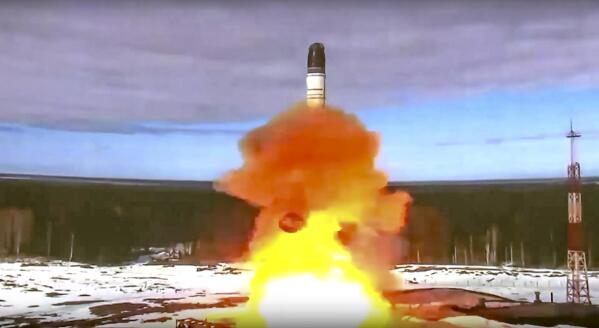By Tony O’Reilly-
Russian President Vladimir Putin has announced the deployment of the fearsome Sarmat intercontinental ballistic missiles (ICBMs), colloquially known as ‘Satan II,’ into combat duty.
The head of Russia’s space agency Roscosmos confirmed this alarming development., adding that the missiles have entered combat duty.
These missiles, renowned for their devastating payload, are capable of carrying ten or more nuclear warheads. Putin’s assertion in June that the Sarmat missiles would be operational “soon” has now materialized into a stark reality, raising concerns worldwide.
Concurrently, in a separate and potentially perilous incident, a Ukrainian drone launched an attack on a Russian town situated near one of the country’s largest nuclear power stations. Russian air defenses managed to intercept drones heading toward three western regions, further intensifying the growing unease.
The Sarmat intercontinental ballistic missiles, ominously nicknamed ‘Satan II,’ have long been the subject of international apprehension. Their deployment into combat duty marks a significant and alarming development in the ongoing geopolitical standoff.
These formidable weapons are renowned for their ability to carry a formidable payload – ten or more nuclear warheads. Their range and power make them a formidable force on the global stage.
The confirmation of the Sarmat missiles’ deployment by Russia’s space agency Roscosmos underscores Russia’s unyielding commitment to fortify its military capabilities.
President Putin’s declaration in June foreshadowed this moment, and it has now come to pass, casting a foreboding shadow over international security.
Meanwhile, a Ukrainian drone initiated a provocative attack on a Russian town, heightening concerns about the regional conflict’s spill-over effects. The targeted town is situated in close proximity to one of Russia’s largest nuclear power stations, raising the stakes and intensifying anxieties.
Reports indicate that Russian air defenses successfully intercepted drones heading toward three western regions, including the Kursk, Belgorod, and Moscow regions.
However, one Ukrainian drone managed to evade interception and inflicted damage to a building in the town of Kurchatov. This town lies just a few kilometers away from the Kursk nuclear power station, compounding fears of the potential fallout of such provocations.
Governor Roman Starovoit initially reported the presence of two drones but later clarified his statement, confirming that a single Ukrainian drone had caused damage to a building’s facade in Kurchatov. Fortunately, no casualties have been reported as a result of this incursion.
However, as of now, there is no official mention of potential damage to the Kursk nuclear power plant itself.
Escalating Tensions on Multiple Fronts
The concurrent events of the Sarmat missiles’ deployment and the provocative drone attack have injected a renewed sense of urgency and concern into an already volatile international landscape. These developments underscore the gravity of the situation and raise several critical questions about the future of global security.
Sarmat Missiles
The Sarmat intercontinental ballistic missiles represent a new threshold in the ongoing arms race and geopolitical tensions. Their formidable capabilities and the potential for massive destruction have ignited concerns about their deployment.
These missiles, with their extended range and payload capacity, could potentially reach distant targets with precision and devastating consequences. The international community’s response to this development will be a topic of intense scrutiny.




